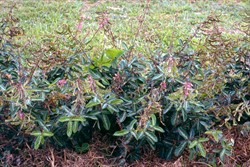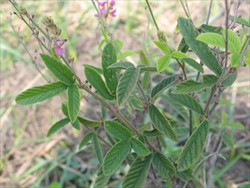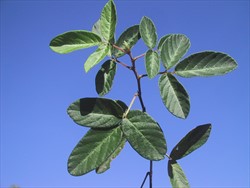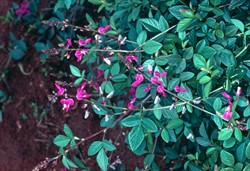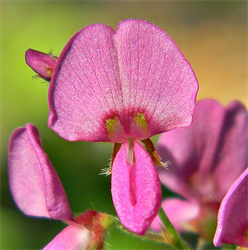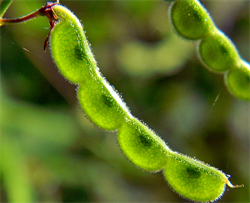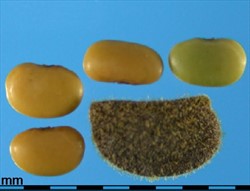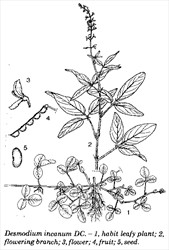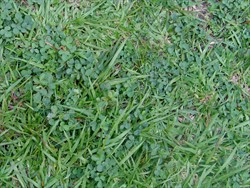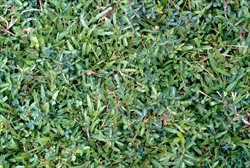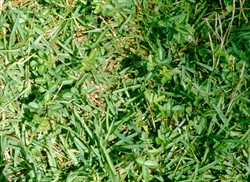Tropical Forages
Basionym: Aeschynomene incana G. Mey.; Desmodium canum (J.F. Gmel.) Schinz & Thell.; Desmodium frutescens Schindl.; Desmodium mauritianum (Willd.) DC.; Desmodium supinum DC.; Hedysarum canum J.F. Gmel.
Basionym: Hedysarum incanum Sw.; Hedysarum mauritianum Willd.; Hedysarum supinum Sw.; Meibomia cana (J.F. Gmel.) S.F. Blake; Meibomia mauritiana (Willd.) Kuntze; Meibomia supina Britton
Family: Fabaceae (alt. Leguminosae) subfamily: Faboideae tribe: Desmodieae subtribe: Desmodiinae.
Ascending to erect perennial herb or low shrub growing to 60 cm tall, in some cases much taller but more typically prostrate and below 20 cm under grazing. Fibrous trailing stems from a deep well-branched root system; stems root readily at the nodes (stolons); inflorescences borne on upright stems. Leaves trifoliolate on petioles up to 3.5 cm long; leaflet shape very variable, round to oval on prostrate stems, lanceolate to elliptical on upright stems. The terminal leaflet may be up to 9 cm long and 4.5 cm wide with lateral leaflets up to 6 cm long and 3 cm wide, but generally the leaves on upper braches are larger and more pointed than those on the lower branches. The upper surface of the leaf is dark green, often with a paler streak along the midrib, but paler and densely pilose on the under surface. The inflorescence is a terminal or axillary raceme, up to 20 cm long with single blue, red or purple flowers; standards up to 6 mm long. The flowers may also be in fascicles of 3. The pods may be up to 4 cm long, with a straight upper margin and strongly indented lower margin, and are covered with hooked hairs; there are up to 8 segments per pod. Seeds are light brown and usually kidney shaped, 1 mm × 0.5 mm. There are 200,000‒500,000 seeds per kg.
Asia: tachi-shiba-hagi (Japan)
Caribbean: sweethearts (Lesser Antilles)
English: beggar weed, creeping beggar weed, kaimi-clover, kaimi, Spanish clover, Spanish tick-trefoil, tick clover; zarzabacoa comun (USA)
French: colle-colle, pois madame
Indian Ocean: famalakantsy, pelatsifotra, savisaha, tialamba (Madagascar)
Latin America: pega-pega, amor seco, amor-de-campo, carrapicho-beiço-de-boi (Brazil); amor seco, cadillo, empanaditas, tajá-tajá, voy contigo (Spanish)
Pacific: ngātoro, piripiri (Cook Islands), ka'imi (Hawaii); lattil pako (Marshall Islands), piripiri 'aratita (Tahiti)
Native:
Northern America: Mexico
Caribbean: Antigua and Barbuda, Bahamas, Barbados, Cuba, Dominica, Guadeloupe, Hispaniola, Jamaica, Martinique, Montserrat, Puerto Rico, St. Kitts and Nevis, St. Lucia, St. Vincent and Grenadines
Central America: Belize, Costa Rica, El Salvador, Guatemala, Honduras, Nicaragua, Panama
South America: Argentina, Bolivia, Brazil, Colombia, Ecuador, French Guiana, Guyana, Paraguay, Peru, Suriname, Venezuela
Naturalized:
Widely naturalized. in paleotropics.
Forage
A potentially useful legume in heavily grazed pastures and on low to moderate fertility soils, as in rundown Urochloa pastures in the Amazon Basin. However, no widespread use.
Environment
Stoloniferous growth habit suggest value as a ground cover in soil conservation.
Other
D. incanum is being successfully tested as an alternative to greenleaf and silverleaf desmodium in controlling the parasitic weed, striga, in push-pull cropping systems in drier areas of East Africa.
Soil requirements
Best adapted to fertile, neutral to alkaline (often found in coralline sands of pH 8.5) soils but can be found on low-fertility soils with textures from sands to medium clays and pH from as low as 4.
Moisture
Adapted to regions with annual rainfall between 1,500 and 3,000 mm, but will persist in areas of 1,000 mm. Can tolerate short-term flooding. Growth during dry season is generally slow but there is important genotypic variation in drought tolerance.
Temperature
Tolerant of frosts at higher altitudes and latitudes, but optimum temperatures are 30/25 ºC during the growing season. Found at elevations from 0 to 1,800 m asl. Survived winter temperatures as low as -13 °C in the Mississippi River Delta, Louisiana, USA, and was the most vigorous of surviving warm-season legumes.
Light
Has moderate shade tolerance; considered a weed in coffee plantations in South America.
Reproductive development
Flowers over a long growing period, October to April in Rio Grande do Sul, Brazil and in south-east Queensland, Australia. Behaves as a short day plant at higher latitudes.
Defoliation
Very tolerant of heavy grazing and frequently found with creeping grasses in heavily and continuously grazed swards.
Fire
Not usually burned because it occurs in locations which are heavily grazed. However, if burnt, it regrows from buds at the base of its woody stems, as well as regenerating from soil seed reserves.
Guidelines for establishment and management of sown forages.
Establishment
Typically established in a fully prepared seedbed or broadcast into existing grasses. Recommended sowing rate of 5 kg/ha; sowing depth about 5 mm. Scarification to break hardseededness may be necessary; inoculation with an appropriate rhizobium strain is recommended. Initial growth is slow, and trailing stems begin to develop some 6 months after sowing.
Fertilizer
Kaimi clover responds to P but is usually grown without fertilizer on moderately fertile soils. Responded to low levels of lime on a Hawaiian oxisol.
Compatibility (with other species)
Competes well with stoloniferous or rhizomatous grasses under heavy grazing.
Companion species
Grasses: Cenchrus clandestinus (higher altitudes in Hawaii), Urochloa humidicola (humid tropical savannas in South America), U. mutica (Belize), Paspalum dilatatum, P. notatum, Dichanthium aristatum.
Pests and diseases
Reported to be sensitive to Peanut (Groundnut) Mottle Virus and may be a source of this to cultivated peanuts and soybeans in southern USA. Several fungal diseases reported, as are little leaf and Desmodium mosaic virus. Seedlings may be damaged by cutworms; rose beetles and cyst nematodes, Heterodera trifolii, have been reported in Hawaii. Light infestations by Meloidogyne spp. nematodes under coffee in Cuba.
Ability to spread
Spreads locally from creeping stems especially when pushed into moist soil. Main spreading via pod segments that stick to animal hair and human clothing (hence the name, 'beggar weed'), while seed can also be spread through cattle faeces.
Weed potential
Common on waste land and roadsides, and so is considered a weed in some circumstances.
Nutritive value
For whole plant material (vegetative stage) high CP concentration (23.5%) and very low IVOMD (36.1%) have been reported; low digestibility probably due to high tannin concentration (0.4‒5.9%).
Palatability/acceptability
Low, due to high tannin concentration. In mixture with Dichanthium aristatum, palatable only in dry season (Guadeloupe).
Toxicity
No toxicity reported.
Dry matter
Yields of 6.5 t DM/ha/year reported but yields are difficult to measure in such a low growing species when it is usually under heavy grazing. Under lenient grazing and with additional Fertilizer, is often less productive than other species such as , but is much more persistent and tolerant of grazing.
Animal production
No information available.
2n = 22. Self-fertile but some outcrossing may occur. Hybrid of × is sterile.
Long flowering period. Best time for harvest is reported to be about 2,000 degree days. Potential yields of over 700 kg/ha are greatly reduced by high rates of flower abortion, giving maximum estimated seed yield of 360 kg/ha. Commercial yields have been around 200 kg/ha.
Considered a weed in coffee plantations in South America but can be controlled with single application of either dalapon (8.0 kg/ha) or diquat (1.0 L/ha). Susceptible to trifluralin, fluchloralin, fluroxypyr-meptyl + triclopyr, 2,4 D + aminopyralid and 2,4 D + picloram.
- Tolerant of continuous heavy grazing.
- Invades and improves run-down grass pastures.
- Seed spread by cattle.
- Good cold tolerance.
- Shade tolerance.
- Effectively controls the parasitic weed striga in maize cropping systems in Africa.
- Low harvestable production.
- No commercial seed.
- High tannin reduces palatability and digestibility.
Cameron, D.G., Jones R.M., Wilson, G.P.M, Bishop, H.G., Cook, B.G., Lee, G.R. and Lowe, K.F. (1989) Legumes for heavy grazing in coastal subtropical Australia. Tropical Grasslands 23:153–161. bit.ly/3bzkTeq
Hacker, J.B. (1992) Desmodium incanum DC. In: Mannetje, L.’t and Jones, R.M. (eds) Plant Resources of South-East Asia No. 4. Forages. Pudoc Scientific Publishers, Wageningen, the Netherlands. p. 112–114. edepot.wur.nl/327785
Imrie, B.C., Jones R.M. and Kerridge, P.C. (1983) Desmodium. In: Burt, R.L., Rotar, P.P., Walker, J.L. and Silvey, M.W. (eds) The role of Centrosema, Desmodium and Stylosanthes in improving tropical pastures. Westview Press, Boulder, CO, USA. p. 97–140.
Midega, C.A.O., Wasonga, C.J., Hooper, A.M., Pickett, J.A. and Khan, Z.R. (2017) Drought-tolerant Desmodium species effectively suppress parasitic striga weed and improve cereal grain yields in western Kenya. Crop Protection 98:94–101. doi.org/10.1016/j.cropro.2017.03.018
‘Tifhardy-1” (PI 206317) Released in Tifton, Georgia, USA (1981). Very winter-hardy and persistent in Paspalum notatum at Tifton, Georgia. Tolerant of poor soils and recommended as a soil cover in Hawaii, USA.
CPI 27826, CPI 37436, CPI 40107 and CPI 40114 All of these accessions persisted in trials in southern coastal Queensland (subtropical environment) but none were progressed to cultivar status.
CIAT 3522 This accession was collected from very low fertility soils in Panama and provided high yields in both the wet and dry season in trials at Rondônia, Amazon basin, Brazil.
PI 364508 This accession demonstrated high drought tolerance and retained leaf longer when compared with other Desmodium spp. in striga-control experiments in cropping systems in Western Kenya.
